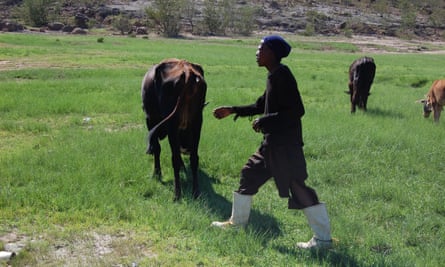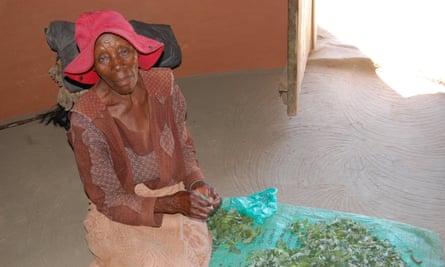Sunday, February 21, 2016
Lesotho Happiness
Friday, February 19, 2016
The crisis of Lesotho's "Green Drought"
Text copied from theguardian.com
For 14-year-old Hopolang Staka, Lesotho’s worst drought in more than four decades means fewer meals, a daily two-hour trek for water and an education postponed.
At the family’s small holding in Mafeteng, 70km south of the capital Maseru, Hopolang, an Aids orphan, supplements the 350 maloti (£15) monthly child support grant from the government with income from herding neighbours’ cattle. He dropped out of school last year because his street hawking brothers couldn’t afford the fees.
A second year of inadequate rains has dried up water sources across the small mountain kingdom, killed livestock and may leave as many as one in three Basotho requiring food aid until next year, according to local UN officials. Lesotho officials say a recent downpour greened Lesotho’s valleys, camouflaging a crisis that’s increasing malnutrition and disease.
“It’s what they call the ‘green drought’,” says Phole Mpobole, assistant administrative officer of Ha Raliemere district in Mafeteng. “The green grass is deceptive, the water table is down. There is nothing in those fields, not even vegetables.”

Three UN agencies – Unicef, the World Food Programme and the Office for the Coordination of Humanitarian Affairs – are responding to the El Niño-induced drought which has also scorched South Africa, Zimbabwe and Malawi, forcing them to declare food emergencies.
Lesotho’s prime minister, Pakalitha Mosisili, last week appealed for $28m (£19.5m) to help feed people, provide water and protect livestock in a country where 80% of the population relies on farming. His government has already set aside $10m. Haretsebe Mahosi, the Disaster Management Authority (DMA) chief executive, says the disease burden is rising along with hunger, estimating 650,000 people need food aid now, with the number expected to rise.
“We don’t have to wait for people to die,” says Tesfaye Shiferaw, the Unicef representative in Lesotho. “We are working under a declared emergency. It is the duty for all of us to respond.” Unicef is appealing for $3m to augment supplies including nutritional supplements for children and water purification tablets.
A Lesotho government drought assessment shows up to 56% of communities are using unprotected water sources; all 10 districts reported disease outbreaks, an increase in gender and sexual violence, a drop in the national herd and increasing food prices because of scarcity and demand.

On a hill a few kilometres east of Hopolang’s home, 74-year-old Marentseng Tjamela says she hasn’t seen a worse drought in her life. On her 550 maloti pension, Tjamela is struggling to feed five orphan grandchildren. She begs and borrows from neighbours after failing to get state child support because of inadequate documents. When four of her five cattle died from a lack of water and disease, she ate them with neighbours.
“Lebitla la khomo ke molomo (the grave of a cow is the mouth),” she says. “There is nothing to give my grandchildren,” she says through an interpreter, adding that on most days they survive on one meal.
The drought will stretch government resources at a time when state revenues have been hit (pdf) by lower commodity prices, reduced earnings from the Southern African Customs Union and declining remittances from South Africa-based workers.
South Africa, which surrounds Lesotho, is itself in danger of slipping into a recession as companies and farmers are retrenching thousands of workers, including Basotho. Unicef says Lesotho already spends the equivalent of 9% of its GDP on social services, one of the highest rates in the world.
In the countryside, social workers say conflict and malnutrition are on the rise, with many people surviving on two meals a day, consisting of porridge and the traditional pap meal of thickened maize meal and vegetables. For many children, their only proper meal is at school, where the WFP is feeding 250,000 children countrywide.
Mary Njoroge, the WFP’s country director, says people are adopting negative coping mechanisms such as eating less, reducing the number of meals per day, buying food on credit, eating one type of food, selling assets, eating seed crop and theft.
“I have never seen anything like it,” says Mabvisa Mabusa, a sub-chief in Mafeteng. “There is a lot of crime; men against men, village against village. People are stealing even during the day. There is a lot of uneasiness in the community.”
At Mafeteng hospital, Matsola Ntlale, the hospital manager, says malnutrition cases are increasing. This year, she has also seen more than 100 anthrax cases. Officials says anthrax cases are on the rise because poor grazing fields are causing cattle to feed on the soil, which sometimes has the disease.
“We haven’t seen any direct deaths from the drought yet but malnutrition cases are rising,” she says. “We have also had some HIV and Aids patients who have stopped taking their medicines saying the drugs make them sick when they don’t eat properly.”
Because of water shortages, large parts of the country are now solely reliant on water trucks, the DMA’s Mahosi said. Most of the money the government is seeking will be used to buy water tankers, medicine, food and other logistics.
He says the government is warily watching accelerating food prices because of the 26% drop in the value of the rand against the major foreign currencies in the past year. Lesotho imports most of its food from South Africa.
“The situation is very tight and we are expecting it to get worse,” Mahosi said. “We want the donors to respond yesterday.”
• Godfrey Mutizwa travelled with Unicef
